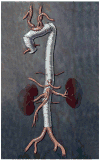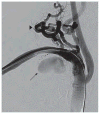Severe aortic and arterial aneurysms associated with a TGFBR2 mutation
- PMID: 17330129
- PMCID: PMC2561071
- DOI: 10.1038/ncpcardio0797
Severe aortic and arterial aneurysms associated with a TGFBR2 mutation
Abstract
Background: A 24-year-old man presented with previously diagnosed Marfan's syndrome. Since the age of 9 years, he had undergone eight cardiovascular procedures to treat rapidly progressive aneurysms, dissection and tortuous vascular disease involving the aortic root and arch, the thoracoabdominal aorta, and brachiocephalic, vertebral, internal thoracic and superior mesenteric arteries. Throughout this extensive series of cardiovascular surgical repairs, he recovered without stroke, paraplegia or renal impairment.
Investigations: CT scans, arteriogram, genetic mutation screening of transforming growth factor beta receptors 1 and 2.
Diagnosis: Diffuse and rapidly progressing vascular disease in a patient who met the diagnostic criteria for Marfan's syndrome, but was later rediagnosed with Loeys-Dietz syndrome. Genetic testing also revealed a de novo mutation in transforming growth factor beta receptor 2.
Management: Regular cardiovascular surveillance for aneurysms and dissections, and aggressive surgical treatment of vascular disease.
Figures





References
-
- Loeys BL, et al. A syndrome of altered cardiovascular, craniofacial, neurocognitive and skeletal development caused by mutations in TGFBR1 or TGFBR2. Nat Genet. 2005;37:275–281. - PubMed
-
- McKusick VA. Heritable Disorders of Connective Tissue. Saint Louis, MO: The CV Mosby Company; 1972.
-
- De Paepe A, et al. Revised diagnostic criteria for the Marfan syndrome. Am J Med Genet. 1996;62:417–426. - PubMed
-
- Dietz HC, et al. Marfan syndrome caused by a recurrent de novo missense mutation in the fibrillin gene. Nature. 1991;352:337–339. - PubMed
Publication types
MeSH terms
Substances
Grants and funding
LinkOut - more resources
Full Text Sources
Medical
Miscellaneous
